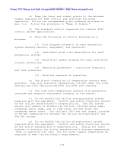
MIL-HDBK-1003/3
b) It is too dangerous to allow untrained personnel to
don SCBA equipment and venture into a known hazardous atmosphere.
For that reason, the Navy has elected not to provide the SCBA,
since there would be no control over who might don the SCBA and
attempt to enter the room.
2.6 Radon Mitigation Systems. The following components of
a sub-slab depressurization system should be included in the
design for buildings which will be constructed on sites known or
suspected of being a source of radon gas and which will be
occupied more than 4 hours a day:
a) Piping. Provide one 3-inch diameter polyvinyl
chloride (PVC) pipe (Schedule 20) through the floor slab for
every 1,000 square feet of slab area located as close to the
center of the area as possible. See Figure 1 for floor
penetration detail. Pipe should extend through the building
roof, concealed in partitions, closets, store rooms, etc. An
adequate length of straight vertical piping should be provided in
the ceiling space below the roof for future installation of the
depressurization fan if post construction testing indicates
excessive radon levels. Locating the fan near the roof or
ceiling establishes a negative pressure in the piping system
thereby minimizing potential of leaks in occupied spaces. Crack
between pipe and slab should be sealed with polyurethane caulk.
Evaluate the economic feasibility of combining several PVC pipes
to reduce the number of risers and the number of roof
penetrations, especially for multi-story buildings.
b) Electrical Requirements. Provide a 110 volt, 15
ampere electrical power supply terminating at convenient
locations near the location for the future depressurization fans
in PVC pipe. Ensure convenient access to locations selected for
future installation of depressurization fans.
21
Simpo PDF Merge and Split Unregistered Version - http://www.simpopdf.com

MIL-HDBK-1003/3
22
Simpo PDF Merge and Split Unregistered Version - http://www.simpopdf.com

MIL-HDBK-1003/3
Section 3: APPLICATIONS
3.1 General. Criteria applicable to specific building
types are listed in Table 3. These criteria apply when specific
requirements are not addressed in this handbook.
3.2 Building Types. MIL-HDBK-1190 is the highest ranking
Navy design criteria, followed by NAVFAC design manuals and
NAVFAC military handbooks. Refer to the EFD or EFA A-E Guide for
(local) submission requirements. Refer to ASHRAE handbooks for
design guidance not shown in Navy criteria.
3.3 Air Force Projects. Air Force criteria shall govern
when different from Navy criteria.
3.4 Tropical Engineering. Refer to MIL-HDBK-1011/1 for
additional design guidance. Some of the problems encountered
with HVAC systems in the tropics are:
a) Corrosion of equipment.
b) Damage by windblown debris and windblown rain.
c) Humidity control. Comfort cooling systems require
cooling of outside air the year around to control humidity.
d) Special pipe insulation and vapor barriers.
e) Damper mechanisms tend to jamb due to corrosion.
3.5 Electronic Facilities. Building types include:
a) Receiver buildings
b) Telephone and switchgear rooms
c) Radio direction-finder facilities
d) Uninterrupted power supply (UPS) rooms
e) Transmitter buildings
f) Computer rooms
g) Control towers
h) Transportable/tactical facilities
I) Transportable/relocatable facilities
23
Simpo PDF Merge and Split Unregistered Version - http://www.simpopdf.com

Building Category Navy Other Guides/ Special
Type Codes Criteria Standards Considerations
(All) (Varies) MILHDBK-1190, ASHRAE Hdbk See 3.2
NAVFAC P-89, Series
& MILHDBKs
A-E Guide NFPA Codes
OSHA 1910
A-E Contract Local &
PED (DD-1391) Regional
Bldg Codes
Local Station
Smoking Regs
USAF (Varies) Current USAF/ (Varies) See 3.3
Projects LEEE, ETLs,
AFMs, USAF
Regional
Civil Engineer
General Design
& Construction
Guidance MILCON
Program
Plus Navy
Criteria
Tropical (Varies) MILHDBK-1011/1 See 3.4
Engineering
Clean (Varies) MILHDBK-1028/5 See Navy
Rooms Criteria
MIL-HDBK-1003/3
j) Permanent facilities
k) Transportable, non-relocatable facilities
Table 3
Applicable Criteria by Building Type
24
Simpo PDF Merge and Split Unregistered Version - http://www.simpopdf.com

Building Category Navy Other Guides/ Special
Type Codes Criteria Standards Considerations
High (Varies) MILHDBK-423 See Navy
Altitude Criteria
Electro-
Magnetic
Pulse
Protection
for Ground-
Based
Facilities
Electronic (Varies) MILHDBK-1012/1 See 3.5
Computer (Varies) MILHDBK-1012/1 See Navy
Rooms Criteria
in Electronic
Facilities
Satellite 131 MILHDBK-1012/1 See Navy
Communication Criteria
Ground Station MIL-STD-210
(this is an
electronic NAVELEX 0101,
facility) 105
Navigation 133 NAVAIR 51- See Navy
& Traffic 137 50AAA-2 Criteria
Aids
Airfield 136 MILHDBK-1023/1 See Navy
Lighting Criteria
USMC 141 NAVFAC P-272 See Navy
Cryogenics Criteria
Facility
Air 141-11 NAVFAC P-272 See Navy
Passenger Criteria
Terminal
MIL-HDBK-1003/3
Table 3 (Continued)
Applicable Criteria by Building Type
25
Simpo PDF Merge and Split Unregistered Version - http://www.simpopdf.com

![Hệ thống HVAC và Dehumidifying: Tổng quan [Năm hiện tại]](https://cdn.tailieu.vn/images/document/thumbnail/2012/20120202/luly_meo1/135x160/hvac_and_dehumidifiying_systems_b_split_14_8134.jpg)
![Hệ thống HVAC và Dehumidifying: Tổng quan [Năm hiện tại]](https://cdn.tailieu.vn/images/document/thumbnail/2012/20120202/luly_meo1/135x160/hvac_and_dehumidifiying_systems_b_split_13_3651.jpg)
![Hệ thống HVAC và Dehumidifying: [Thêm từ mô tả/định tính để tăng CTR]](https://cdn.tailieu.vn/images/document/thumbnail/2012/20120202/luly_meo1/135x160/hvac_and_dehumidifiying_systems_b_split_12_8041.jpg)
![Hệ thống HVAC và Dehumidifying: [Thông tin chi tiết/Hướng dẫn/Lựa chọn]](https://cdn.tailieu.vn/images/document/thumbnail/2012/20120202/luly_meo1/135x160/hvac_and_dehumidifiying_systems_b_split_11_4149.jpg)
![Hệ thống HVAC và hệ thống hút ẩm: [Thông tin chi tiết/Hướng dẫn/Lựa chọn tốt nhất]](https://cdn.tailieu.vn/images/document/thumbnail/2012/20120202/luly_meo1/135x160/hvac_and_dehumidifiying_systems_b_split_10_7992.jpg)
![HVAC và Hệ thống Hút Ẩm: [Thêm thông tin chi tiết để tối ưu SEO]](https://cdn.tailieu.vn/images/document/thumbnail/2012/20120202/luly_meo1/135x160/hvac_and_dehumidifiying_systems_b_split_9_3668.jpg)

![HVAC và Dehumidifying Systems: Hệ thống điều hòa không khí và hút ẩm [chuẩn SEO]](https://cdn.tailieu.vn/images/document/thumbnail/2012/20120202/luly_meo1/135x160/hvac_and_dehumidifiying_systems_b_split_7_2859.jpg)
![HVAC và Dehumidifying Systems: [Mô tả chi tiết/Hướng dẫn/Đánh giá]](https://cdn.tailieu.vn/images/document/thumbnail/2012/20120202/luly_meo1/135x160/hvac_and_dehumidifiying_systems_b_split_6_8164.jpg)
![Hệ thống HVAC và Dehumidifying: [Thông tin chi tiết/Hướng dẫn/Lựa chọn]](https://cdn.tailieu.vn/images/document/thumbnail/2012/20120202/luly_meo1/135x160/hvac_and_dehumidifiying_systems_b_split_5_3816.jpg)








![Ngân hàng trắc nghiệm Kỹ thuật lạnh ứng dụng: Đề cương [chuẩn nhất]](https://cdn.tailieu.vn/images/document/thumbnail/2025/20251007/kimphuong1001/135x160/25391759827353.jpg)






